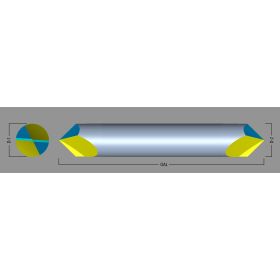A chamfer cutter, or even a chamfer mill, is available at any machine shop, assembly floor, or hobbyist’s garage. These cutters are simple tools which are employed for chamfering or beveling any section in a wide selection of materials. Many reasons exist to chamfer a part, including fluid flow and safety, to part aesthetics.

Due to the diversity of needs, tooling manufacturers offer a number of angles and sizes of chamfer cutters, and also various kinds of chamfer cutter tip geometries. Harvey Tool, for example, offers 21 different angles per side, starting from 15° to 80°, flute counts of 2 in order to six, and shank diameters starting at 1/8” around 1 “.
After getting a tool using the exact angle they’re trying to find, an individual may have to choose a certain chamfer cutter tip that might work best with their operation. Common varieties of chamfer cutter tips include pointed, flat end, and end cutting. These three kinds of chamfer cutter tip styles, offered by Harvey Tool, each serve a distinctive purpose.
Three Varieties of Harvey Tool Chamfer Cutters
Type I: Pointed
This kind of chamfer cutter will be the only Harvey Tool option which will come to some sharp point. The pointed tip allows the cutter to complete in smaller grooves, slots, and holes, compared to another two sorts. This style also permits easier programming and touch-offs, considering that the point can be easily located. It’s because of its tip this form of the cutter has the longest period of cut (together with the tool earning any finished point), when compared to flat end of the other chamfer cutters. With simply a couple flute option, this is actually the most simple type of a chamfer cutter offered by Harvey Tool.
Type II: Flat End, Non-End Cutting
Type II chamfer cutters have become like the type I style, but feature a conclusion that’s ground into an appartment, non-cutting tip. This flat “tip” removes the pointed section of the chamfer, which is the weakest area of the tool. For this reason difference in tool geometry, it emerges a different measurement for a way a lot longer the tool could be whether or not this stumbled on a spot. This measurement is called “distance to theoretical sharp corner,” which helps using the programming in the tool. The advantage of the flat end from the cutter now provides for multiple flutes to exist on the tapered profile with the chamfer cutter. With more flutes, this chamfer has improved tool life and handle. The flat, non-end cutting tip flat does limit its utilization in narrow slots, but an additional advantage can be a lower profile angle with better angular velocity in the tip.
Type III: Flat End, End Cutting
Type III chamfer cutters are a better plus much more advanced type of the kind of II style. The kind III possesses a flat end tip with 2 flutes meeting at the center, setting up a center cutting-capable form of the sort II cutter. The guts cutting geometry on this cutter can help you cut using its flat tip. This cutting enables the chamfer cutter to lightly reduce the very top of an important part towards the bottom from it, instead of leave material behind when cutting a chamfer. There are lots of situations where blending of a tapered wall and floor should be used, and that is where these chamfer cutters shine. The tip diameter can be held to a tight tolerance, which significantly aids in programing it.
In summary, there can be many suitable cutters to get a single job, and you will find many questions you have to ask ahead of picking your ideal tool. Selecting the best angle comes down to being sure that the angle around the chamfer cutter matches the angle for the part. One needs to be cautious of precisely how the angles are called out, as well. May be the angle an “included angle” or “angle per side?” Is the angle cancelled of the vertical or horizontal? Next, the better the shank diameter, the stronger the chamfer and the longer the size of cut, however, interference with walls or fixtures need to be considered. Flute count depends upon material and handle. Softer materials tend to want less flutes for better chip evacuation, while more flutes will be finish. After addressing all these considerations, the right style of chamfer for your job needs to be abundantly clear.
For more details about chamfer cutter see our webpage
